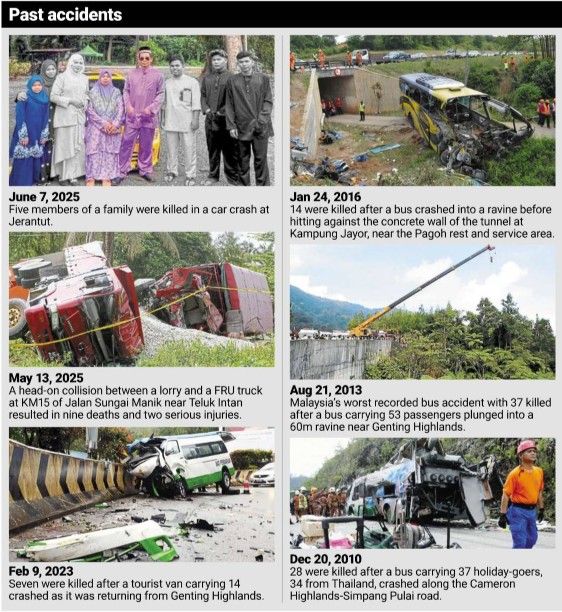TWO days ago, they were home on holiday, celebrating Aidiladha. Today, 15 students who had bright futures ahead of them are no more.
And all because of a road accident, when an apparently speeding bus hit the back of a multipurpose vehicle (MPV) on a dark, unlit road before toppling over and skidding on its side.
So many parents have been left distraught, devastated and in disbelief. So many hopes for the future have been dashed, and so many dreams are up in smoke.
Beside the 15 students dead, another 27 were injured.
Road accidents are almost always avoidable. Yet they are the No. 1 cause of death for Malaysians aged below 40, and the fourth biggest killer overall. One person is killed on Malaysian roads every two hours – that is 12 a day, and close to 4,500 a year!
Of course, until we know more, we cannot rush to blame anyone for yesterday’s tragedy but the stories that are coming out tell us that so much needs to be done.
So many things had gone wrong. The road was downhill and winding. Were there speed breakers there?
ALSO READ: Student: It all unfolded so quickly
Survivors say they smelled something burning just before the accident; that the bus was speeding and swerved erratically as it hurtled downhill.
According to the bus company, the vehicle was only recently serviced while the driver was brought in as a replacement from another company. He was an experienced driver who knew the road well.
So what caused the bus to rear-end the MPV?
It will be some time before we know what happened, but one thing is for sure – accidents like this are happening way too often.
Just last month – on May 11, Mothers Day – a baby elephant was killed in an accident with a lorry, leaving its mother shell-shocked, standing beside the dead calf as if trying to wake it up. It was an accident that had the nation in tears.
Two days later, nine Federal Reserve Unit personnel were killed in an accident that involved their vehicle and a lorry laden with rocks.
The list just goes on.
According to a study by the Malaysian Institute of Road Safety Research (Miros), a fatal road accident involving a heavy vehicle happens roughly every 36 hours.
In the last six years, there have been about 1,500 deaths from around 3,500 heavy vehicle-related accidents across the country.
“Miros’ studies also revealed that only 32% of public transport and commercial vehicle operators complied with the Industrial Code of Practice for Transport Safety (ICOP) in 2022,” road safety activist Datuk Mohamad Hisham Shafe reportedly said in May.
What can we do to put an end to these deaths on the roads?
For one, we can slow down heavy vehicles with speed limiters, which prevent them from going over a fixed speed.
It’s mind-boggling that our leaders first thought of this idea back in 2015 but never got around to fully implementing it.
Now, 10 years later, Transport Minister Anthony Loke says they are drawing up plans to enforce use of the device.
The government first said it would enforce the use of speed limiters in commercial vehicles from Jan 1, 2015, for new model vehicles and in-production vehicles – an idea that was to be fully implemented from Jan 1, 2017.
But as in so many things Malaysian, there was a hue and cry over the company that was awarded exclusive rights to install speed limiters. Lorrymen also claimed it would be dangerous.
And the idea was put on a slow back-burner. Meanwhile, people continue to die.
ALSO READ: Fatal crash site a dark and winding stretch, say police
Speed limiters reduce the risk of major accidents. As the force of a collision increases exponentially with speed, every kilometre per hour reduced translates to potentially saved lives.
Today’s speed limiters are also more advanced, they can track the drivers and can tell if he is an aggressive or smooth driver.
That will help the authorities weed out the bad drivers.
Then there are bad roads. Slippery roads need to be identified and remedial action taken, downhill roads need speed breakers, potholes need fixing, and more reflective signs are needed.
As for the East-West Highway stretch, it is a dark road.
The driver in the elephant case, for instance, said he had not seen the calf beside the road before it ran in front of his vehicle.
The authorities should have acted then and forced vehicles to slow down on that stretch – or even ban traffic on the road after dark. After all, such a ban has been recommended for smaller vehicles.
Now, we have lost 15 bright minds who could have brought so much to the country. It is so sad.
However, what is really tragic is that we could have done something to prevent it.



